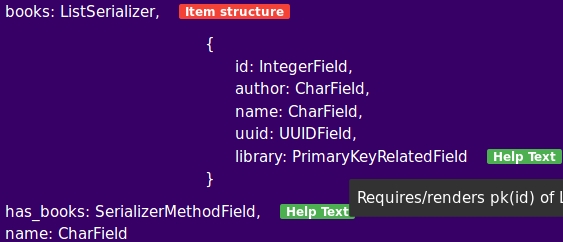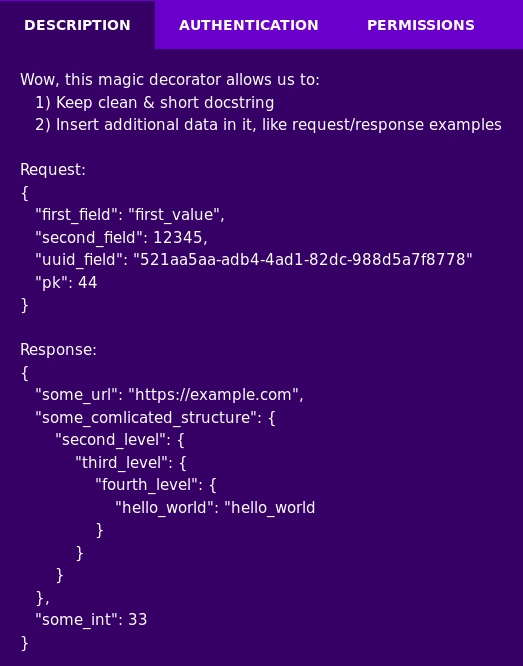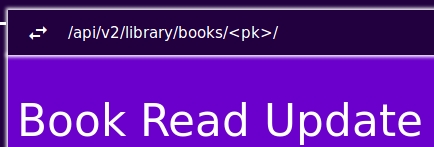Ultimately automated DRF documentation rendering(UNMAINTAINED)
THIS REPO IS NO LONGER MAINTAINED. PLEASE CONSIDER OTHER AUTOMATED DOCUMENTATION PACKAGES
Automated api documentation renderer




@format_docstring(request_example, response_example=response_example)class BookReadUpdateHandler(RetrieveUpdateAPIView):"""Wow, this magic decorator allows us to:1) Keep clean & short docstring2) Insert additional data in it, like request/response examplesRequest: {}Response: {response_example}"""

In virtualenv:
pip install drf_autodocs
In settings:
INSTALLED_APPS = [...'drf_autodocs',...]
In your urls:
urlpatterns = [...url(r'^', include('drf_autodocs.urls')),]
That’s already enough for swagger-like docs,
result available on
localhost:8000/docs/
If you want functional views support and some more features, read below.
Tree-like structure is built from url prefixes. To make your endpoints grouped by some
category, you must include your urls within other url. There are, generally, 2 ways to achieve it:
Example 1:
university_urlpatterns = [url(r'^lecturers/', university_views.LecturersHandler.as_view(), name='lecturers'),url(r'^lecturers/(?P<pk>\d+)/$', university_views.LecturerUpdateHandler.as_view(), name='lecturer_read_update'),url(r'^universities/', university_views.UniversitiesHandler.as_view(), name='universities'),]urlpatterns = [url(r'^library/', include(library_urlpatterns, namespace='library')),url(r'^university/', include(university_urlpatterns, namespace='university')),]
Example 2:
urlpatterns = [url(r'^library/', include(library_urlpatterns, namespace='library')),url(r'^university/', include([url(r'^lecturers/', university_views.LecturersHandler.as_view(), name='lecturers'),url(r'^lecturers/(?P<pk>\d+)/$', university_views.LecturerUpdateHandler.as_view(), name='lecturer_read_update'),url(r'^universities/', university_views.UniversitiesHandler.as_view(), name='universities')], namespace='university')),]
Say you have a view like this:
class BookReadUpdateHandler(RetrieveUpdateAPIView):serializer_class = BookUpdateSerializerqueryset = Book.objects.all()
And say this serializers’ input is different from output:
class BookUpdateSerializer(serializers.ModelSerializer):class Meta:fields = ('name', 'author')model = Bookdef to_representation(self, instance):return LibrarySerializer(instance.library)
Now to know what return format is, one must make a request.
This package simplifies it via:
response_serializer_class = YourSerializer
Now your view looks like:
class BookReadUpdateHandler(RetrieveUpdateAPIView):"""Shiny and nice docstring, which:1) allows formatting2) `allows markdown`"""serializer_class = BookUpdateSerializerresponse_serializer_class = LibrarySerializerqueryset = Book.objects.all()
from .request_response_examples import request_example, response_examplefrom drf_autodocs.decorators import format_docstring@format_docstring(request_example, response_example=response_example)class BookReadUpdateHandler(RetrieveUpdateAPIView):"""Wow, this magic decorator allows us to:1) Keep clean & short docstring2) Insert additional data in it, like request/response examplesRequest: {}Response: {response_example}"""serializer_class = BookUpdateSerializerresponse_serializer_class = LibrarySerializerqueryset = Book.objects.all()
Please think twice before using such parameters, as they might be unneeded.
But if you really need them, here you go:
class LibrariesHandler(ListCreateAPIView):"""Shiny and nice docstring, which:1) allows formatting2) `allows markdown`"""extra_url_params = (('show_all', 'Bool', 'if True returns all instances and only 5 otherwise'),('some_extra_param', 'Integer', 'Something more to be included there'))
Results in:

For functional views, decorate them with.
drf_autodocs.decorators.document_func_view
Now you can insert into view via kwargs:
Now it should look like:
from drf_autodocs.decorators import document_func_viewformat_args = ['"This string\nwas inserted"',]@document_func_view(serializer_class=BookSerializer,response_serializer_class=LibrarySerializer,doc_format_args=format_args)@api_view(['GET', 'POST', 'DELETE'])def hello_world(request):"""Works for `functional` views too!Yeah, that thing rocks!And allows formatting {}"""return Response('hello_world response')
This package uses default DRF field attribute help_text
If you’re using ModelSerializer, and model field got help_text attr, it will be
transferred to your serializers’ field automatically.
Example:
from rest_framework import serializershas_books = serializers.SerializerMethodField(help_text='returns Bool')
Note that specifying help_text on serializers’ field overrides the one from model
To change application look & feel, override templates and/or static files.
Root template is :templates/drf_autodocs/index.html
For additional parsers(if you want other structure than tree), inherit from
drf_autodocs.parser.BaseAPIParser
Endpoint names could use view names or url names, replacing ‘_’ and ‘-‘ with ‘ ‘ and capitalizing output.
Default behavior is to use url names:
url(r'^books/(?P<pk>\d+)/$', library_views.BookReadUpdateHandler.as_view(), name='book_read_update'),
will result in:

If you want to use endpoint(view) names instead, do this in settings:
AUTODOCS_ENDPOINT_NAMES = "view"
Thanks to django, django-REST for their awesome work,
and drf-docs for source of inspiration as well as some parts of code.
Developed with care by Mashianov Oleksander at
If you  this, don’t forget to
this, don’t forget to  it and share with friends.
it and share with friends.